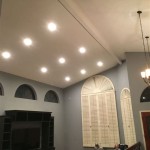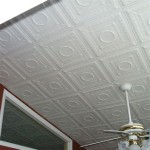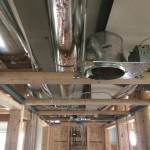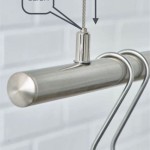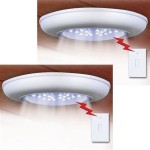Determining the Appropriate Ceiling Fan Size for a Living Room
Selecting the correct size ceiling fan for a living room significantly impacts its performance and aesthetic appeal. An undersized fan will struggle to circulate air effectively, while an oversized fan can overwhelm the space and potentially cause discomfort. Careful consideration of room dimensions, ceiling height, and other factors is crucial to ensure optimal comfort and energy efficiency.
The primary function of a ceiling fan is to move air, creating a cooling effect in summer and distributing warm air in winter. The fan's ability to perform these functions is directly related to its blade span, which is the diameter of the circle the blades create when spinning. A larger blade span moves more air, making it suitable for larger rooms. Selecting the appropriate blade span is therefore essential for achieving the desired level of air circulation.
Beyond functionality, a ceiling fan also contributes to the overall décor of the living room. Choosing a fan that is proportional to the room's size and style enhances the visual harmony of the space. A fan that is too small might appear insignificant, while a fan that is too large can dominate the room and disrupt its balance.
Understanding Blade Span and Room Size
The most important factor in determining the correct ceiling fan size is the square footage of the living room. A general guideline correlates blade span with room size as follows:
- Rooms up to 75 square feet: A ceiling fan with a blade span of 36 inches or less is typically sufficient. These smaller fans are suitable for very small living rooms or areas within a larger living room, such as a reading nook.
- Rooms between 76 and 144 square feet: A ceiling fan with a blade span of 42 to 44 inches is generally appropriate. This size range is well-suited for small to medium-sized living rooms.
- Rooms between 144 and 225 square feet: A ceiling fan with a blade span of 50 to 54 inches is recommended. These fans are effective in circulating air in medium to larger living rooms.
- Rooms between 225 and 400 square feet: A ceiling fan with a blade span of 56 inches or larger is necessary. For very large living rooms or open-concept spaces, consider using multiple ceiling fans to ensure adequate air circulation.
These are general recommendations, and slight adjustments may be necessary based on other factors, such as ceiling height and the layout of the room. It is always advisable to err on the side of a slightly larger fan if unsure, as a larger fan can always be run at a lower speed.
To accurately determine the square footage of the living room, measure the length and width of the room and multiply these two numbers together. This calculation provides the total area in square feet, which can then be used to determine the appropriate blade span.
The Impact of Ceiling Height
Ceiling height plays a critical role in determining the optimal performance of a ceiling fan. The distance between the fan blades and the floor affects the effectiveness of air circulation. For standard ceiling heights of 8 feet, a flush-mount or hugger-style fan is typically the best option. These fans are designed to sit close to the ceiling, maximizing the distance between the blades and the floor.
For ceilings higher than 8 feet, a downrod is necessary to lower the fan to the appropriate height. The ideal distance between the fan blades and the floor is between 7 and 9 feet. Using a downrod ensures that the fan is positioned at the optimal height for circulating air throughout the room without being too close to occupants.
The length of the downrod needed depends on the ceiling height. A general guideline is:
- 9-foot ceilings: Use a 6-inch downrod.
- 10-foot ceilings: Use a 12-inch downrod.
- 11-foot ceilings: Use an 18-inch downrod.
- 12-foot ceilings: Use a 24-inch downrod.
For ceilings higher than 12 feet, longer downrods may be required. It is crucial to consult with a professional electrician or ceiling fan specialist to determine the appropriate downrod length for very high ceilings.
When calculating the downrod length, it's important to consider any obstructions in the room, such as tall furniture or lighting fixtures. The fan blades should have sufficient clearance to operate safely and effectively. A properly installed ceiling fan with the correct downrod length will optimize air circulation and enhance the comfort of the living room.
Other Considerations for Optimal Fan Performance
Beyond blade span and ceiling height, several other factors can influence the performance of a ceiling fan in a living room. These include the pitch of the blades, the motor type, and the design of the fan blades.
Blade Pitch: The blade pitch refers to the angle of the fan blades. A steeper blade pitch generally moves more air but may also produce more noise. A blade pitch between 12 and 15 degrees is typically considered optimal for most living rooms. Fans with a steeper pitch are often used in industrial settings or large, open spaces where maximum air circulation is required.
Motor Type: The motor type affects the fan's energy efficiency and noise level. DC (Direct Current) motors are generally more energy-efficient and quieter than AC (Alternating Current) motors. DC motors also often offer more speed settings, allowing for finer control over air circulation. While DC motor fans tend to be more expensive upfront, their energy savings over time can offset the initial cost.
Blade Design: The design of the fan blades can also impact its performance. Blades with a wider surface area tend to move more air, while blades with a more aerodynamic design may be quieter. The material of the blades can also affect their performance and durability. Blades made of wood or metal are generally more durable than those made of plastic.
Room Layout and Obstructions: The layout of the living room and the presence of furniture or other obstructions can affect air circulation. If the room is heavily furnished or has multiple partitions, consider using multiple ceiling fans to ensure that air is circulated evenly throughout the space. Positioning the fan in a central location in the room will also maximize its effectiveness.
Fan Location Relative to Windows and Doors: Consider the placement of windows and doors when positioning the ceiling fan. A fan placed near a window can help to circulate fresh air throughout the room. Conversely, placing a fan near a drafty door can exacerbate drafts. Optimizing the fan's location in relation to these elements can enhance its overall effectiveness.
Lighting Considerations: Many ceiling fans come with integrated lighting fixtures. When selecting a ceiling fan, consider the lighting needs of the living room. Choose a fan with a light fixture that provides adequate illumination for the space. LED lighting is a popular choice due to its energy efficiency and long lifespan. Ensure the light output (measured in lumens) is appropriate for the room's size and intended use.
Careful consideration of these factors, in addition to blade span and ceiling height, will help to ensure that the selected ceiling fan provides optimal comfort and energy efficiency in the living room. While aesthetic considerations are important, prioritizing functionality is key to achieving the desired level of air circulation and comfort.

Ceiling Fan Size Guide Delmarfans Com

How To Select The Right Size For Every Room

Ceiling Fan Size Guide Delmarfans Com

Ceiling Fan Size Guide Delmarfans Com

Ceiling Fan Size Guide Find The Perfect For Your Room

Ceiling Fan Size Guide Delmarfans Com

How To Measure A Ceiling Fan Hunter

What Size Ceiling Fan Is Best For Your Room

Ceiling Fans Sizing Guide How To Select The Perfect Size Fan For Your Space

Affordable Modern Ceiling Fans Must Have
Related Posts



